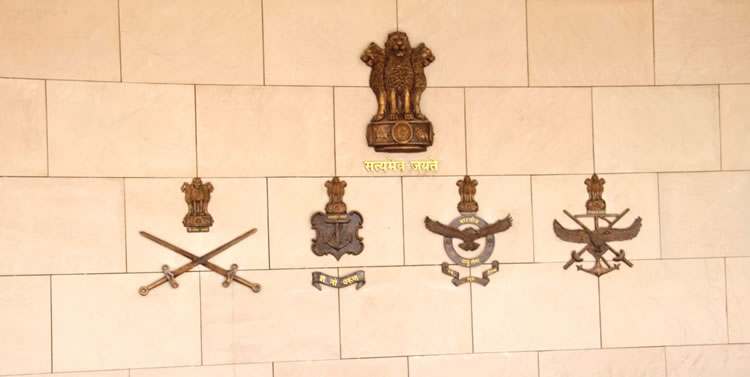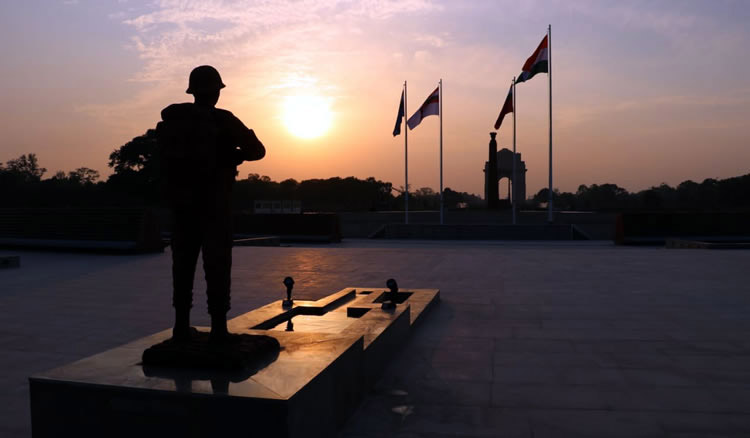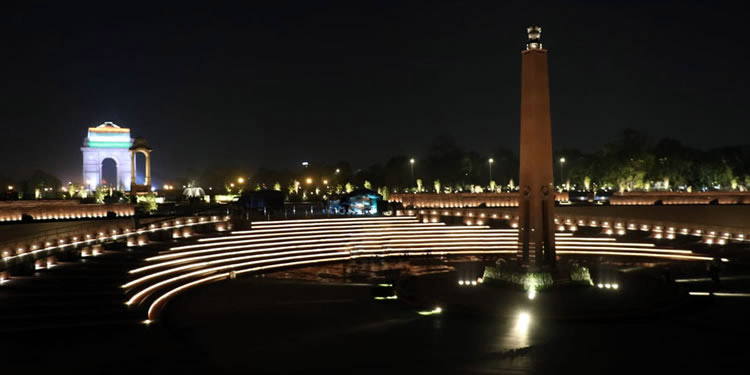- Prime Minister Narendra Modi inaugurates Aero India 2023 in Bengaluru; Releases Commemorative Stamp
- Defence Secretary meets delegations from Saudi Arabia, USA and Oman on the sidelines of Aero India 2023
- Foreign Ministers of 32 countries to attend Aero India 2023
- Embraer showcases the C-390 Millennium at Aero India 2023
India gets a National War Memorial in the heart of New Delhi
Supreme Sacrifice by 25,942 troops since Independence gets a place of honour: All ceremonial wreath laying to shift from India Gate to new Memorial
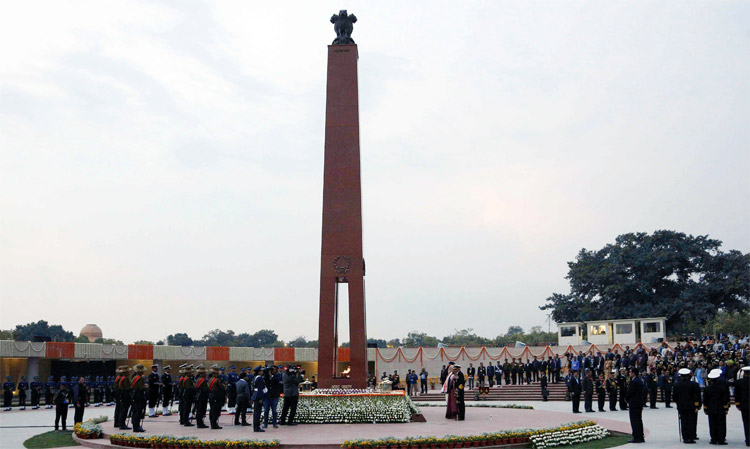
The National War Memorial was dedicated to the nation by Prime Minister Narendra Modi on February 25, bringing the supreme sacrifice made by 25,942 military troops since Independence centre-stage to New Delhi's capitol complex.
When Modi lit the eternal flame at the base of a central obelisk at the heart of the Memorial complex to honour the memory of the soldiers who fell in battle to uphold national integrity, it fulfilled a six-decade-old emotive demand by the armed forces.
"All ceremonial wreath-laying by national and international dignitaries will now be shifted from India Gate to the National War Memorial," announced Lt General PS Rajeshwar, chief of the Integrated Defence Staff, who oversaw the completion of work on this 176 Crore project in one year. The inter-service guard will also shift to the War Memorial.
The Tyag Chakra comprises concentric walls of honour with names of soldiers killed in action inscribed in letters of gold on granite tablets embedded in the walls. Each martyred soldier has an independent brick to his name, which makes this complex unique. The circular concentric walls of honour represent the ancient war formation 'Chakravyuh'.
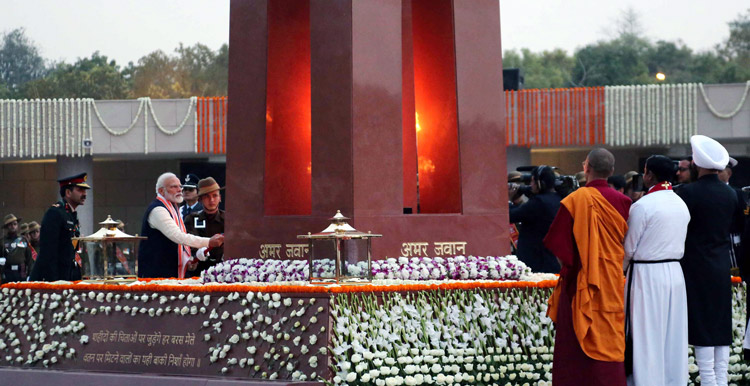
India Gate was raised in 1931 to commemorate 83.000 Indian troops who had laid down their lives in World War-I and the Third Anglo-Afghan Wars. An inverted rifle bayonet with a helmet on top was installed under the India Gate arch in January 1972 to commemorate India's victory in the 1971 War and as a tribute to troops who laid down their lives in the War. Respects to the fallen soldiers have been paid by dignitaries at India Gate since then. The new War Memorial is located in the C Hexagon area between India Gate and the National Stadium, and spread over a 40-acre complex, making it one of the largest in the world.
The Memorial complex is built around four concentric circles - Amar Chakra (Circle of immortality), Veerta Chakra (Circle of Bravery), Tyag Chakra (Circle of Sacrifice) and Rakshak Chakra (Circle of Protection).
A 15.5-metre granite obelisk is at the heart of four concentric circles. The eternal flame at the base of this obelisk syumbolises the immortality of the spirit of the fallen soldiers with the assurance that the Nation shall never forget their sacrifices. The iconic verse by the poet Jagdambika Pal Hitaishi to commemorate the immortality of martyrs is inscribed under the eternal flame.
The Veerta Chakra is a covered, sunken gallery with six bronze murals depicting the valour of the Indian soldier in famous battles.
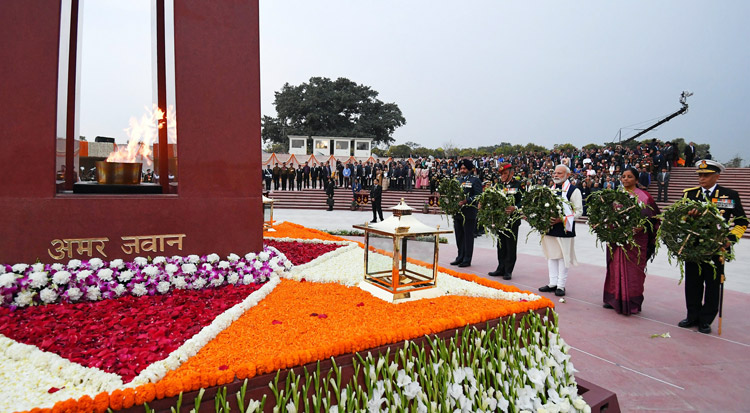
The Tyag Chakra comprises concentric walls of honour with names of soldiers killed in action inscribed in letters of gold on granite tablets embedded in the walls. Each martyred soldier has an independent brick to his name, which makes this complex unique. The circular concentric walls of honour represent the ancient war formation 'Chakravyuh'.
The fourth Circle on the outer periphery - the Rakshak Chakra (Circle of Protection) - with the row of trees representing a reassurance to the nation about its safety against any threat. Each tree represents soldiers who ensure the territorial integrity of the nation.
The Param Yodha Sthal is an adjoining park dedicated to recipients of the nation's highest gallantry award, the Param Vir Chakra (PVC). Busts of all 21 PVC awardees are installed in the landscaped park.
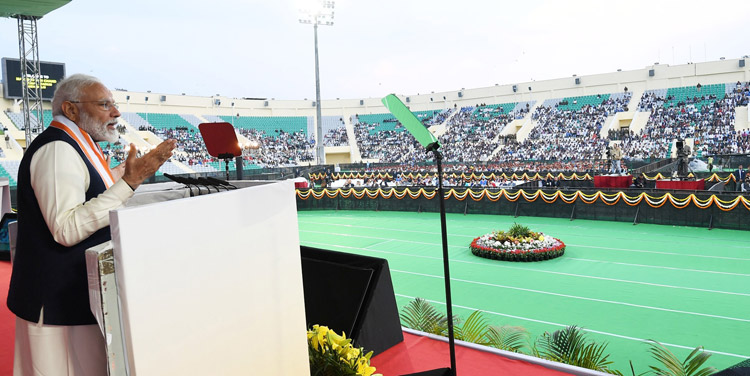
"The design for the Memorial was selected through a global competition. Yogesh Chanrahsan of WeBe Design Lab, Chennai, won the competition and was appointed project consultant. M/s NCC Ltd was awarded the contract for the construction of the complex," explained Major General Alok Raj, the chief project coordinator, who also conducted the Prime Minister around the Memorial complex during the dedication ceremony. The murals and busts have been sculpted by Ram Suthar.
Lt General Rajeshwar said the Memorial was intended to be a place of pilgrimage. "It is aimed at instilling national pride and a sense of patriotism. it will be an inspiration to the next generation and help the cause of nation building," he said.
Entry would be restricted to a maximum of 250 persons at a time. "The public should respect the regulation of footfall. It is a pious place and we expect a certain order," Major General Raj informed. But two public plazas will be kept open round the clock.
